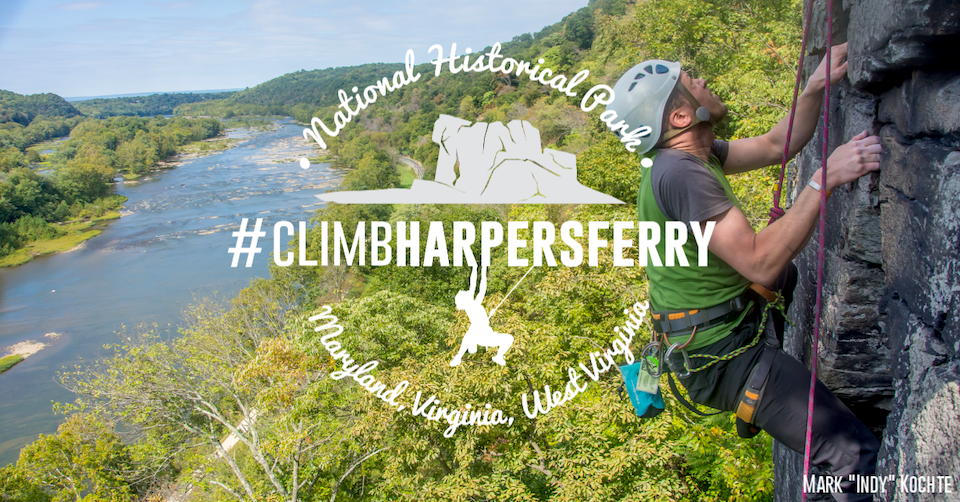Climbers upset over closures at Harpers Ferry National Historical Park in West Virginia and Virginia have written letters to park officials to express their frustration, and now are pushing a public campaign to persuade park officials to open the areas.
Harpers Ferry Superintendent Tyrone Brandyburg, who arrived at the park in February 2017, announced the closures in June that year in the superintendent's compendium, or book of regulations and rules.
Closed to the public are all rock climbing activities including traditional, top rope, belay, lead climbing, bouldering, etc.
Within the legislative boundaries of Harpers Ferry National Historical Park, in the states of Virginia and West Virginia. These include, but are not limited to, the following climbing and bouldering areas:
• All areas on “Loudoun Heights”, including the Main Cliff
• Chestnut Hill Cliff • Giggling Boulders
• The Frontier
• Short Virginia Cliffs
• Paw Paw overhang
• The Wide Spot cliffs
• Ridge Top boulder
• Shenandoah River boulders
• Shenandoah Area Boulders
All cliffs along Shenandoah Street in the Lower Town of Harpers Ferry, WV
Justification: Due to limited and treacherous access for rescue personnel, their locations near or within culturally sensitive areas and general poor rock quality, and a lack of available legal and safe parking, these areas within the park are closed to all climbing related activities. A public closure to climbing of these areas will serve to mitigate the potential risk to the visiting population and those engaged in search and rescue activities associated with climbing. A less restrictive method to accomplish this goal will not be effective.
But members of Mid Atlantic Climbers and Access Fund, a national organization that advocates for climbers, took exception to the closure, saying they disagreed with the justifications and that their input wasn't seriously considered.
In a letter sent to Superintendent Brandyburg in early February, they said that while they have met "several times over the past two years" to talk about rock climbing in the historical park and contribute to the park's climbing management plan, "our input has been largely ignored and climbing closures have been instituted without reasonable justification, NEPA analysis, or opportunities for public comment."
"We ask that the closures of climbing in the WV and VA portions of the park be lifted and that the temporary closure to climbing on Maryland Heights due to the landslide and construction vehicle traffic on Sandy Hook road also be lifted," they added. "We believe that there is not sufficient evidence to warrant these closures and ask that you lift the closures in next Superintendent’s Compendium."
While the superintendent's compendium described the rock in the areas as poor in quality, the climbing groups said they don't know of any studies to support that contention. As to the park's claim that closing the areas to climbers "will serve to mitigate the potential risk to the visiting population," Mid Atlantic Climbers and the Access Fund pointed out that "(T)here are well over 80 national parks with over 3000 documented climbing areas. NPS recreation managers across the country do not close climbing because other visitors see climbers. Nearby parks, such as Great Falls, attract thousands of visitors who see climbers on cliffs. There is no evidence that seeing climbers leads others to attempt dangerous activities."
On Friday, the two groups launched a public campaign to lobby the park to reopen the routes.
Harpers Ferry National Historical Park is highly valued by the local climbing community, as it contains traditional climbing, bouldering, and top roping opportunities located in close proximity to a major metropolitan area. But even though Mid Atlantic Climbers had worked in partnership with the Park since 2014, climbing access was closed in the Virginia and West Virginia sections of the Park in 2017 without consideration of stakeholder input and without consultation with local and national climbing organizations. In 2018, the Park further restricted access by temporarily closing Maryland Heights to climbing, and that closure remains in effect today.
WE NEED YOUR HELP: Harpers Ferry continues to ignore our request to lift these climbing closures and to develop a collaborative climbing management plan based on public input and best practices. Park leadership needs to hear that climbing access is an important resource for our community. Please send a message today...




Comments
Climbers are excellent stewards and should be allowed beneficial use of the park